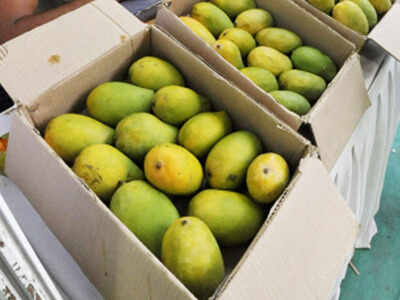
RAJKOT: Bad news, kesar mango lovers. Your wait to taste the delicious mangoes got a little longer this year. The crop is expected to be delayed by two months because of the extended monsoon last year.
Again, mango farmers fear that sudden rise in temperature may adversely affect yield, though they hipe to go to the market mid may with the king of fruits. However, in many farms it is still at the flowering stage.
There are three major districts – Gir Somnath, Junagadh and Amreli – well known for Saurashtra’s kesar mango production. Generally, buds appear in the first week of February and by mid-February, markets start selling raw mangoes, used for pickling, preservation purposes or for general daily consumption.
Jayesh Hirpara, a kesar mango farmer in Jamvada Gir area of Talala in Junagadh district said, “Generally the flowering period for mango is 45 to 50 days. But this time it has extended to almost 70 days. A few farmers have accused last year’s anthracnose disease to the delay this year. Buds require low temperature and if temperatures increase suddenly, it will badly affect our crop.”
Professor D K Varu head of department of fruit science in Junagadh Agriculture university (JAU) said that the extended monsoon has delayed the entire crop pattern. Mango has been delayed by nearly 45 days this season, he said. The current temperature is favourable for mango budding, but if there is high fluctuation between day and night temperatures, it will affect setting of fruits, he said, adding that cloudy atmosphere even once in a week will result in fungal diseases in the fruits.
Ukka Bhatti, who owns a mango orchard in Hitla village of Dhari taluka in Amreli district said that winter is the most suitable for pollination. “This year because of delayed crop we fear less yield. The average kesar mango production of three regions of Gir area is nearly 2 lakh metric tonne per season,” he added.
Again, mango farmers fear that sudden rise in temperature may adversely affect yield, though they hipe to go to the market mid may with the king of fruits. However, in many farms it is still at the flowering stage.
There are three major districts – Gir Somnath, Junagadh and Amreli – well known for Saurashtra’s kesar mango production. Generally, buds appear in the first week of February and by mid-February, markets start selling raw mangoes, used for pickling, preservation purposes or for general daily consumption.
Jayesh Hirpara, a kesar mango farmer in Jamvada Gir area of Talala in Junagadh district said, “Generally the flowering period for mango is 45 to 50 days. But this time it has extended to almost 70 days. A few farmers have accused last year’s anthracnose disease to the delay this year. Buds require low temperature and if temperatures increase suddenly, it will badly affect our crop.”
Professor D K Varu head of department of fruit science in Junagadh Agriculture university (JAU) said that the extended monsoon has delayed the entire crop pattern. Mango has been delayed by nearly 45 days this season, he said. The current temperature is favourable for mango budding, but if there is high fluctuation between day and night temperatures, it will affect setting of fruits, he said, adding that cloudy atmosphere even once in a week will result in fungal diseases in the fruits.
Ukka Bhatti, who owns a mango orchard in Hitla village of Dhari taluka in Amreli district said that winter is the most suitable for pollination. “This year because of delayed crop we fear less yield. The average kesar mango production of three regions of Gir area is nearly 2 lakh metric tonne per season,” he added.
Trending Topics
LATEST VIDEOS
City
 Students complain of 'Mass molestation' at Gargi college fest, Delhi Police and Principal face heat
Students complain of 'Mass molestation' at Gargi college fest, Delhi Police and Principal face heat  Won't be surprised if Kejriwal loses from New Delhi seat: Kapil Mishra
Won't be surprised if Kejriwal loses from New Delhi seat: Kapil Mishra  Jamia students-Delhi Police scuffle: Now cops appeal to protesting students
Jamia students-Delhi Police scuffle: Now cops appeal to protesting students  Anti-CAA march: Scuffle between Jamia students and Delhi Police; proctor urges students to step back
Anti-CAA march: Scuffle between Jamia students and Delhi Police; proctor urges students to step back
More from TOI
Navbharat Times
Featured Today in Travel
Get the app



